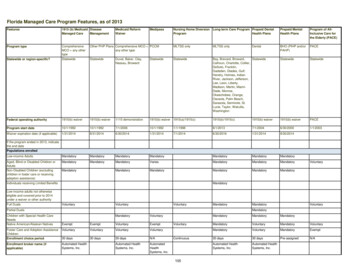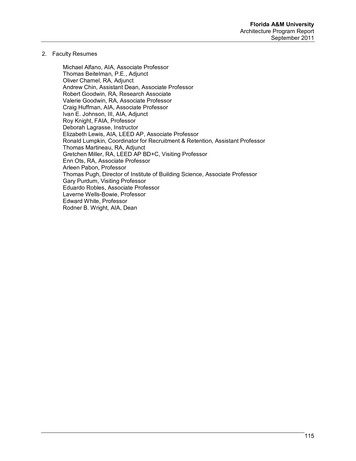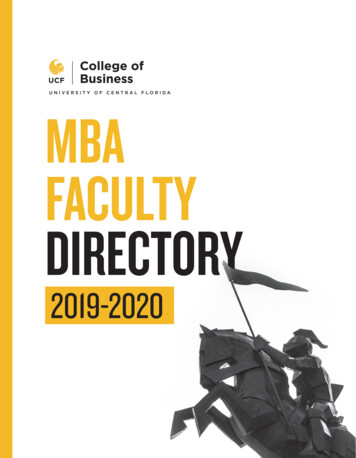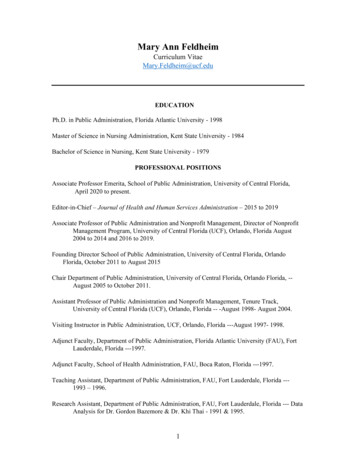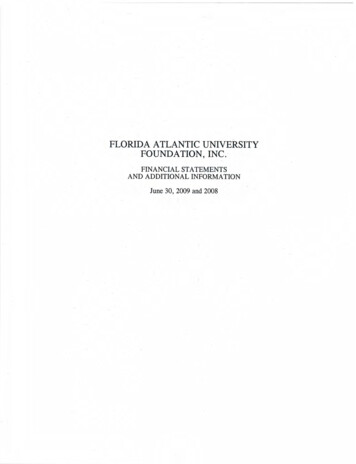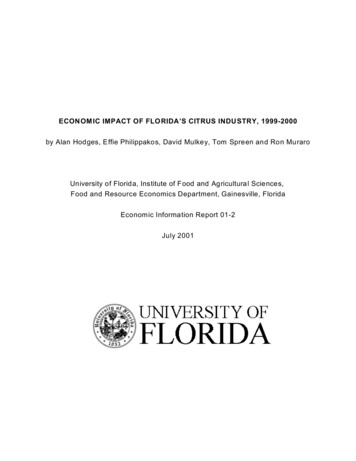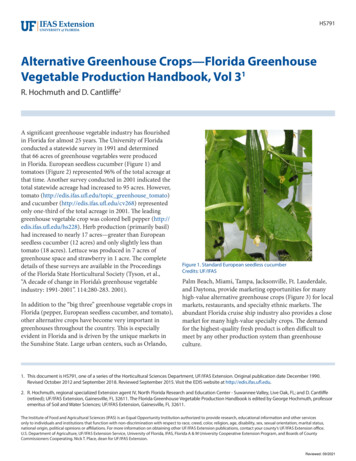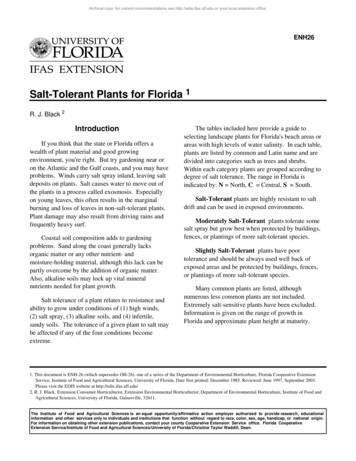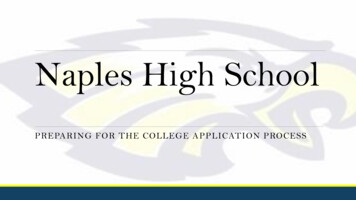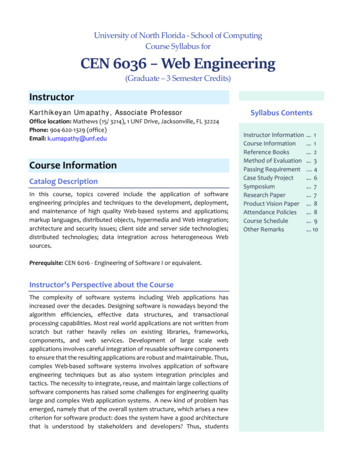
Transcription
University of North Florida - School of ComputingCourse Syllabus forCEN 6036 – Web Engineering(Graduate – 3 Semester Credits)InstructorKarthikeyan Umapathy, Associate ProfessorOffice location: Mathews (15/ 3214), 1 UNF Drive, Jacksonville, FL 32224Phone: 904-620-1329 (office)Email: k.umapathy@unf.eduCourse InformationCatalog DescriptionIn this course, topics covered include the application of softwareengineering principles and techniques to the development, deployment,and maintenance of high quality Web-based systems and applications;markup languages, distributed objects, hypermedia and Web integration;architecture and security issues; client side and server side technologies;distributed technologies; data integration across heterogeneous Websources.Prerequisite: CEN 6016 - Engineering of Software I or equivalent.Instructor’s Perspective about the CourseThe complexity of software systems including Web applications hasincreased over the decades. Designing software is nowadays beyond thealgorithm efficiencies, effective data structures, and transactionalprocessing capabilities. Most real world applications are not written fromscratch but rather heavily relies on existing libraries, frameworks,components, and web services. Development of large scale webapplications involves careful integration of reusable software componentsto ensure that the resulting applications are robust and maintainable. Thus,complex Web-based software systems involves application of softwareengineering techniques but as also system integration principles andtactics. The necessity to integrate, reuse, and maintain large collections ofsoftware components has raised some challenges for engineering qualitylarge and complex Web application systems. A new kind of problem hasemerged, namely that of the overall system structure, which arises a newcriterion for software product: does the system have a good architecturethat is understood by stakeholders and developers? Thus, studentsSyllabus ContentsInstructor InformationCourse InformationReference BooksMethod of EvaluationPassing RequirementCase Study ProjectSymposiumResearch PaperProduct Vision PaperAttendance PoliciesCourse ScheduleOther Remarks. 1. 1. 2. 3 4. 6. 7. 7. 8. 8. 9. 10
Reference BooksThere is no prescribed textbookfor this course. See below forrecommendedreferencematerials for different coursetopics.Web Engineering1.WebEngineering:APractitioner's Approach byRoger Pressman and David Lowe(ISBN: 9780073523293)Software Architecture2. Software Architecture inPractice by Len Bass, Paul C.Clements, and Rick Kazman(ISBN: iewsandBeyond by Paul C. Clements, andet al. (ISBN: heory,andPractice by Richard N. Taylor,Nenad Medvidovic, and EricDashofy (ISBN: 9780470167748)Service-Oriented Computing5. Service-Oriented Architecture:A Field Guide to Integrating XMLand Web Services by Thomas Erl(ISBN: 9780131428980)6. RESTful Web Services byLeonard Richardson, and SamRuby (ISBN: 9780596529260)7. Building Microservices by SamNewman (ISBN: signResearchinInformation Systems: Theoryand Practice by Alan Hevner, andSamirChatterjee(ISBN:9781441956521)learning to create and document software architectures is an important andmust have skillset. I have designed this course with software architecturesas the central topic.This course will address some of the issues associated with large-scale Webapplication development including architectural design and documentation,and service-oriented computing technologies. In the first block of the course,we aim to understand the concepts behind software architectures for largescale Web-based systems as well as to design, recognize, evaluate anddocument software architectures. In the second block, we extend ourunderstanding of service-oriented architecture. In particular, we focus onprinciples behind service-oriented software engineering, and approachesand methods for efficient service production in service ecosystems.Learning OutcomesUpon completion of the course, students should be able to: Employ techniques to analyze and evaluate software architectures on areal-world large-scale web-based software systems. Create and document a reference architecture for a non-trivial Webbased technological product. Present findings of case study analysis of software architectures of afamily of large-scale web-based software systems. Envision an innovative product for a wicked problem and develop anarchitecture for the product that utilizes service-oriented computingtechnologies Write a research-in-progress paper on a Web engineering topic thatutilizes Design Science Research methodology and adheres to appropriateacademic standards.Method of TeachingLecture, in-class activities, group projects, research papers, andpresentations
Method of EvaluationAssessment ItemWeb Technologies Architecture Case StudyDeliverable 1 – System TutorialDeliverable 2 - System ArchitectureDeliverable 3 - Architecture ComparisonDeliverable 4 - Reference ArchitectureCase Study Project PresentationDesign Science Research PaperFirst DraftInterim DraftFinal DraftNew Product Vision PaperProduct Pitch PresentationFinal Vision DraftClass ParticipationSub TotalTotalTeam AssessmentIndividual %5%79%Letter grades will be based on:94 – 100 A90 – 93.99 A87 – 89.99 B 84 – 86.99 B80 – 83.99 B77 – 79.99 C 70 – 76.99 C60 – 69.99 Dless than 60 FThe penalty for cheating or plagiarizing on assignments will be F grade in the course. Work which is similarbeyond coincidence will automatically be considered cheating by all parties.Late AssignmentsThere will be a penalty of 10 % per day for late submission of assignments (including weekends and holidays).Course Passing RequirementIn order to pass this course, at minimum 50% of grade points must be obtained for eachassessment item. If you received less than 50% grade points for one of the assessment item,then you will receive F as the final letter grade.
Academic DishonestyUNF will not tolerate academic dishonesty in any form as it is contrary to the process of learning. Studentsshould demonstrate academic integrity in all of their course works. Students who violate university rules onacademic dishonesty will be punished with the most severe penalty allowed by the university policy.Please review the University policy on academic misconduct at:https://www.unf.edu/president/policies 2 0640P.aspxThe policy on academic integrity and misuse of computer equipment and computer accounts found athttp://www.unf.edu/ccec/computing/Policies Guidelines.aspx.Violations of Academic IntegrityUnder this heading the University of North Florida Student Handbook identifies several types of violations;these include but are not limited to: cheating; fabricating and falsifying information or citations; submitting thesame work for credit in more than one course; plagiarizing; providing another student with access to one’s ownwork to submit under this person’s name or signature; destroying, stealing, or making inaccessible library orother academic resource material; and helping or attempting to help another person commit an act of academicdishonesty. The University of North Florida authorizes any instructor who finds evidence of cheating, plagiarism,or other wrongful behavior that violates the University of North Florida Academic Integrity Code to takeappropriate action. Possible action includes, but is not limited to, failing the student on the work in question,failing the student for the course, notifying the appropriate academic dean or Vice President for Student Affairs,and requesting additional action be taken. The consequences of a breach of academic integrity may result in anF, which is unforgivable, regardless of withdrawal status.Course Outcomes, Assignments, and Activities MatrixCourse outcomesEmploy techniques to analyzeandevaluatesoftwarearchitectures on a real-worldlarge-scale web-based softwaresystems.Assignments/AssessmentsCase Study Deliverable 1 –System TutorialCase Study Deliverable 2 System ArchitectureCase Study Deliverable 3 Architecture ComparisonActivities Performed by StudentsDownload and install a large-scale Webapplication system, report on systemdetails, develop a tutorial to install, run,and use the system, and analyze thesource code of the system to identifymodule, component and connector, andallocation views.Create and document a reference WebTechnologies Identify variants and invariants witharchitecture for a non-trivial Web- Architecture Case Study architecture of selected systems,based technological product.Deliverable 4describe the invariants and the variationpoints using three viewtypes (module,component and connector, allocation),and produce a diagrammatic view ofreference architecture for the family ofselected systems.Present findings of case study Case Study Presentation at Present the findings from the case studyanalysis of software architectures the SoC Symposiumanalysis project at the symposium in aof a family of large-scale webposter format.based software systems.
Course outcomesAssignments/AssessmentsEnvision an innovative product Product Pitch Presentationfor a wicked problem and develop New Product Vision Paperan architecture for the productthat utilizes service-orientedcomputing technologiesActivities Performed by StudentsIdentify a real-world practical problem,describe an ideal product solution for theproblem, develop high-level gies, develop implementationplan to develop the product, present theproduct vision ideas as a 10 minuteproduct pitch presentation, and write avisionpaperfollowingexpectedacademic standards.Write a research-in-progress Research Paper – First Identify an applied research problem,paper on a Web engineering topic Draftread relevant literature, write summary ofthat utilizes Design Science Research Paper – Interim relevant and important articles, develop aResearch methodology and Draftresearch plan following design scienceadheres to appropriate academic Research Paper – Final research methodology, develop highDraftstandards.level architecture for research prototype,develop mockups for the prototype,develop an evaluation plan, and write anacademic research paper that meetsstandards of a well-known conferencerelevant to course topics.DeliverablesWeb Technologies Architecture Case StudyAt the heart of every well-engineered Web applications is its software architecture. Software architecture dealswith the key design decisions underlying a software system, reflected in the system's high-level building blocks.This project will involve architectural recovery of large and complex open source systems and the comparisonof their architecture according to important architectural properties (e.g., extensibility, reliability, performance).You will perform a case study analysis on the architecture of a set of actual systems related to a Webtechnologies topic, and report on your findings.Team experience (Group contract due: Week 2)Students are expected to form a team of 3 or 4 students for the case study project.Deliverable 0 – Systems Selection (Due: Week 3)Each team member should select an open source system that is similar to each other. Select systems that aresimilar to each other based on feature sets or product domain categories. You can use OpenHub(https://www.openhub.net) for finding appropriate open source software system. OpenHub will indicate whichprojects are similar to each other. Selected system should be large, architecturally interesting, and relevant toWeb technologies.Deliverable 1 – System Tutorial (Due: Week 6)Each team member should describe the selected system in regards to what it does, the main features, thenumber of lines of code, the number of contributors, number of commits, number of downloads, the mainprogramming languages used in the system, and estimated cost. Then, write a step-by-step tutorial on (1) whereand how to download the source code, (2) how to compile and install the system including dependencies of the
system, (3) how to run system, (4) how to use the system, and (5) demonstrate the system features using a casestudy example.Deliverable 2 - System Architecture (Due: Week 10)Each team member should describe module views, component and connector (C&C) views, and allocation viewsfor the selected system. Software architecture practice utilizes the concept of architectural views which arerepresentation of a set of system elements and the relations associated with them. There are three architecturalview types: module, component-and-connector (C&C), and allocation. Module views displays static structure ofthe system as a set of implementation units, C&C views displays system runtime behavior characteristics as aset of cooperating units, and allocation views displays how the system is allocated to structures in the system’senvironment.Deliverable 3 - Architecture Comparison (Due: Week 14)Each team member will compare three aspects (functional or non-functional) of the selected system’sarchitecture. The three aspects do not need to be of the same granularity or of the same nature, but at minimumone aspect should be fine-grained.Deliverable 4 - Reference Architecture (Due: Week 16)In this deliverable, describe a reference architecture for the family of selected systems you analyzed as a team.During generational evolution of the system, changes in the architecture are very likely to occur. Systemarchitectures should encompass these variations into their design. Identify at least five invariants and threevariation points in your systems. Then, describe the invariants and the variation points using three viewtypes(module, components and connectors, allocation). For each viewtype, identify the invariants and variationpoints, and indicate how each system fulfill (or not) these invariants and variation points.School of Computing Symposium (Due: Week 16)CEN 6036 students have option of presenting their case study analysis project work as a poster at the School ofComputing Symposium this spring to be held on Friday, April 22, 2016 from 3 PM to 6 PM. Note that you shouldplan to arrive at the University Center around 2 PM to have sufficient time to check-in and set up your poster.April 22nd is one of the spring 2016 study break days. If you are not able to present at the symposium due tostudy break, please contact the instructor during the first week of the course, i.e., on or before January 14, 2016.Instructor will identify alternative public speaking presentation opportunity for those who are not willing topresent at the symposium.Design Science Research-in-Progress PaperEach student is required to write a research proposal for an applied research project. In the proposal, clearlystate a research problem that will have practical impact, develop high-level architecture and design solution forthe problem, and develop evaluation plan to assess the utility of (implemented) solution. Topic selected for theresearch paper should be in an area that is cross-section of topics covered in the course and student’s thesistopic. In the research paper, students are mandated to use Design Science Research methodology to conducttheir research work.
Topic Selection (Due: Week 4)Submit following information in regards to selected topic for the research paper: briefly describe specific topicthat will be focus of the research paper, explain why this topic is relevant to the course, briefly describe howthis topic relates to your master thesis, briefly describe objectives of the research paper and how you intend toachieve it, indicate to which conference you intend to model the paper to it meets expected academic standards,and finally, explain why you selected this conference.First Draft (Due: Week 8)First draft submission must contain following sections: title, abstract, introduction, and problem definition.Interim Draft (Due: Week 13)Interim draft submission must contain following sections: update the sections submitted in the first draft,literature review, research methodology, and work-in-progress research prototype.Final Draft (Due: Week 16)Final draft submission must contain all expected sections fully complete and must be updated as per remarksprovided by the instructor on previous draft submissions. Expected sections are: title, abstract, introduction,problem definition, literature review, research methodology, work-in-progress research prototype, evaluationplan, and conclusion.New Product Vision PaperWeb technology and related gadgets have become a necessity to accomplish our daily activities. The quick paceat which the technology is advancing and it’s increasing impact on the society makes it important to reflect onwhat the future holds. This vision paper assignment welcomes ground-breaking positions, analysis, critiquesand inspiring proposals about relevant aspects and emerging future trends of Web engineering in general andservice computing in particular. This assignment encourages discussion of radical new directions and potentiallydisruptive software and system engineering innovations. To achieve this assignment goal, you are expect towrite a new product vision paper that aims to advance the state of practice in relevance to service computingand enhance your knowledge on service-oriented computing concepts. Vision paper should describe aninnovative product that utilizes service-oriented technology in a novel way to solve a real world problem.New Product Vision Paper Proposal (Due: Week 5)The vision paper proposal submission should include paper title, short description of the proposed system, anda summary of its novel characteristics, functions, and features. You are strongly encouraged to discuss yourchoice of new product with the instructor before you submit your proposal.Product Pitch Presentation (Presentation Dates: Weeks 13 and 14)Each student, on one of the above mentioned dates, will be asked to provide overview of the new product as a10 minute in-class presentation. Students are expected to present their work-in-progress product vision. Thepresentation must cover following: target audience and demographic information; problem description andwhy it is non-trivial; product description including name, function, and price; product highlights and value (whythe product will be useful) claims; innovative and uniqueness of the product; architecture and high-level designdetails (a visual representation recommend); role of service-oriented technologies within the product; productimplementation plan; and prototype mockups.
Final New Product Vision Paper (Due: Week 16)Submission must contain all expected sections fully complete. As you may note that vision paper does not haveintermediate draft submission. Thus, you are highly encouraged to meet with instructor on regular basis toobtain feedback on your vision paper. Expected sections are: title, abstract, introduction, background, problemdescription, product description, architecture and design, implementation plan, product tutorial, andconclusion.Attendance and Class ParticipationIt is important to attend the class regularly, participate, and contribute in the class discussions. Classparticipation includes attendance, participation in class discussions, and overall knowledge and interest in thecourse materials. Class participation grade would be linked to your attendance and participation. Whileattendance may not necessarily be taken every day, both excessive absences and attendance would be dulynoted. In case of excessive absence ( 50%), will result in zero grade for class participation. In the case of extremeabsence ( 25%), you may be given failing grade for the entire course, as the extreme absence equals to nottaking the course.
Mathews (15/ 3214), 1 UNF Drive, Jacksonville, FL 32224 . Phone: 904-620-1329 (office) Email: k.umapathy@unf.edu. Course Information Catalog Description In this course, topics covered include the application of software engineering principles and techniques to the development, deployment,

